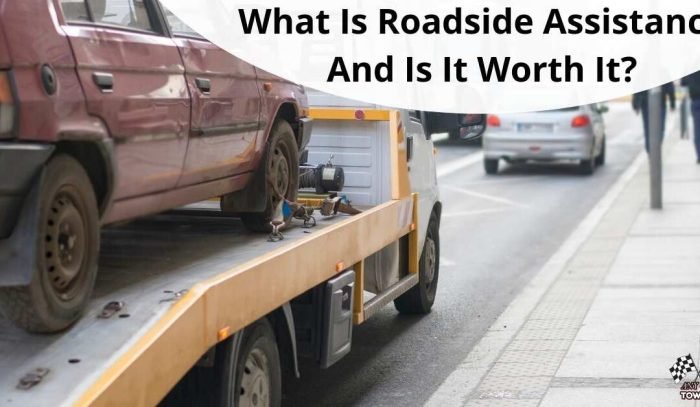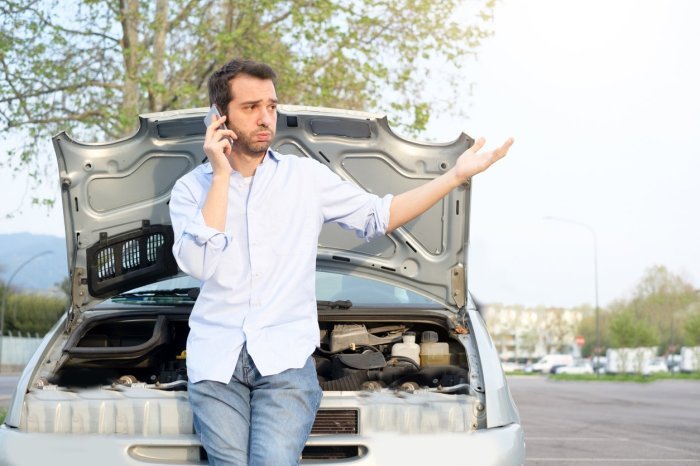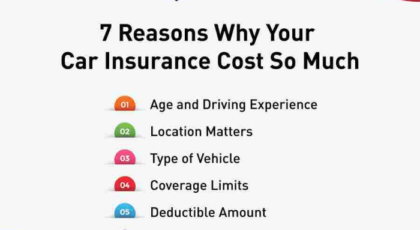Is It Worth Paying for Roadside Assistance?
Is It Worth Paying for Roadside Assistance Coverage in Your Car Insurance? That’s a question many drivers grapple with. The unexpected can happen anytime, leaving you stranded with a flat tire, dead battery, or locked out of your car. Weighing the cost of roadside assistance against the potential inconvenience and expenses of a roadside emergency is crucial for making an informed decision.
This article explores the various factors to consider, helping you determine if adding this coverage to your car insurance policy is the right choice for you.
We’ll delve into the cost comparisons of standalone roadside assistance versus insurance-included options, exploring the different types of coverage available and how frequently such services are actually needed. We’ll also examine alternatives like AAA memberships and discuss how geographic location and vehicle type can influence your decision. Finally, we’ll look at real-world customer experiences and offer tips for reviewing your insurance policy to ensure you’re getting the best value for your money.
Table of Contents
ToggleCost Comparison of Roadside Assistance
Deciding whether to add roadside assistance to your car insurance policy often comes down to cost. Comparing the price of standalone roadside assistance plans with the added cost of including it in your insurance package is crucial for making an informed decision. This comparison will highlight the price variations and help you understand what you’re paying for.
Average Annual Costs
The average annual cost of standalone roadside assistance varies greatly depending on the provider and the level of coverage offered. You might find basic plans for as little as $30 annually, while more comprehensive packages can cost upwards of $150. In contrast, adding roadside assistance to your car insurance policy usually adds a relatively small amount to your overall premium, often between $10 and $30 per year, depending on your insurer and coverage level.
However, this increase is heavily dependent on your existing insurance policy and the level of coverage you’re already paying for. A higher premium for comprehensive coverage might already include many roadside assistance features, thereby minimizing the additional cost.
Factors Influencing Price Variation
Several factors influence the price of roadside assistance, regardless of whether it’s a standalone service or an add-on to your insurance. These include the level of coverage (e.g., towing distance limits, types of services included), the provider’s reputation and operational costs, and your geographic location (rural areas may have higher costs due to longer distances for service). Insurance companies also consider your driving history and the type of vehicle you insure when determining the premium, a factor not always present in standalone roadside assistance plans.
Discounts might be available for bundling services or for customers with clean driving records, further affecting the final cost.
Price Comparison Table
The following table compares the approximate annual cost of roadside assistance from three major insurance providers, highlighting key features included in each plan. Remember that these are estimates, and actual costs may vary based on location, coverage level, and individual circumstances. It’s always best to contact the insurance provider directly for a personalized quote.
| Insurance Provider | Approximate Annual Cost (with insurance) | Towing Distance | Other Features |
|---|---|---|---|
| Company A | $20 | Up to 100 miles | Flat tire change, jump start, lockout service |
| Company B | $25 | Up to 150 miles | Flat tire change, jump start, lockout service, fuel delivery (limited amount) |
| Company C | $35 | Unlimited miles | Flat tire change, jump start, lockout service, fuel delivery, emergency roadside repairs (limited) |
Types of Roadside Assistance Coverage: Is It Worth Paying For Roadside Assistance Coverage In Your Car Insurance?

Source: com.au
Roadside assistance, a valuable add-on to many car insurance policies, provides crucial help when you’re stranded. Understanding the different types of coverage offered and their limitations is key to making an informed decision about whether or not to purchase it. This section details the common services included and the potential exclusions you should be aware of.Roadside assistance packages vary widely in the services they offer.
While the specifics depend on your insurer and the chosen plan, several common services are frequently included.
Common Roadside Assistance Services
Many policies include a core set of services designed to address common roadside emergencies. These typically include towing, jump starts, flat tire changes, and lockout service. Towing covers the transport of your vehicle to a nearby repair shop or your chosen destination, usually within a specified distance. Jump starts provide assistance if your battery dies, while flat tire changes offer on-site tire repair or replacement (often with a spare tire).
Lockout service helps if you’ve locked your keys in your car.
Limitations and Exclusions in Roadside Assistance Policies
It’s crucial to understand that roadside assistance isn’t a limitless safety net. Policies often include limitations and exclusions. For instance, there might be limits on the distance your vehicle can be towed, a maximum number of service calls per year, or restrictions on the types of vehicles covered. Some policies may exclude certain situations, such as accidents caused by driver negligence or damage resulting from mechanical failure not directly related to a covered incident (like a flat tire caused by running over debris).
Deciding if roadside assistance is worth the extra cost on your car insurance policy depends on your individual needs. For families, choosing the right coverage is crucial, and you can learn more about that process in this helpful guide: Car Insurance for Families: How to Choose the Right Coverage in America. Ultimately, weighing the potential cost savings against the convenience of roadside assistance will help you make the best decision for your family’s budget and driving habits.
Furthermore, coverage may not extend to certain locations, such as remote areas or private property. Always carefully review the policy’s terms and conditions to fully understand what’s covered and what’s not.
Comparison of Basic and Comprehensive Roadside Assistance Plans
The table below illustrates the typical differences between basic and comprehensive roadside assistance plans. Remember that specific coverage details can vary significantly between insurance providers.
| Feature | Basic Plan | Comprehensive Plan |
|---|---|---|
| Towing Distance | Up to 25 miles | Up to 100 miles |
| Number of Service Calls per Year | 2 | Unlimited |
| Services Included | Towing, jump starts, flat tire change | Towing, jump starts, flat tire change, lockout service, fuel delivery, winching |
| Additional Benefits | None | Trip interruption reimbursement, emergency transportation |
Frequency of Roadside Assistance Needs
Determining how often you’ll need roadside assistance is tricky, as it depends heavily on several factors. These include the age and condition of your vehicle, your driving habits, the climate you live in, and even the type of roads you frequently travel. While precise statistics are difficult to obtain across all demographics, we can look at general trends to get a better understanding.It’s difficult to pinpoint exact statistics on roadside assistance frequency for specific age groups and car types due to the lack of publicly available, comprehensive data sets.
Insurance companies typically hold this information, but it’s usually proprietary. However, we can make some reasonable inferences. Older vehicles, for instance, are statistically more likely to experience mechanical failures than newer ones, leading to a higher need for roadside assistance. Similarly, drivers with longer commutes or those frequently driving in harsh weather conditions might require assistance more often.
Roadside Assistance Scenarios and Their Likelihood
Understanding the situations where roadside assistance is beneficial helps assess its value. While some incidents are more common than others, the potential inconvenience and cost of dealing with them without assistance can be significant.The probability of needing roadside assistance varies greatly depending on numerous factors. However, certain scenarios are more likely than others, and the severity of the consequences can range from minor inconvenience to significant danger and expense.
- Flat Tire: This is arguably the most common roadside assistance call. The probability is relatively high, especially for drivers who frequently travel on less-maintained roads or experience tire punctures due to road debris. Severity is generally low, but changing a tire in unsafe locations or during inclement weather can increase the risk.
- Dead Battery: A dead battery is another frequent reason for roadside assistance calls, often caused by leaving lights on, extreme temperatures, or a failing battery. Probability is moderate, increasing with vehicle age and harsh weather conditions. Severity is moderate; being stranded, especially at night or in remote areas, can be inconvenient and potentially dangerous.
- Lockout: Locking your keys in your car is surprisingly common. The probability is moderate, influenced by individual forgetfulness or accidental key fob malfunction. Severity is generally low, though it can be inconvenient and potentially costly if a locksmith is required.
- Fuel Exhaustion: Running out of gas is preventable but still happens. Probability is low if you regularly monitor your fuel gauge, but it increases with longer trips and inattentive driving habits. Severity can range from minor inconvenience to significant danger, especially in remote areas or during extreme weather.
- Mechanical Failure: This encompasses a wide range of problems, from engine trouble to transmission issues. The probability is lower than flat tires or dead batteries but significantly higher for older vehicles. Severity is high, often requiring towing and expensive repairs.
Alternatives to Insurer Roadside Assistance
Many drivers assume that roadside assistance is only available through their car insurance provider. However, several alternative options offer comparable or even superior coverage at potentially lower costs. Exploring these alternatives allows for a more informed decision about the best way to protect yourself on the road.Choosing the right roadside assistance plan depends on individual needs and driving habits.
Deciding if roadside assistance is worth the extra cost on your car insurance depends on your individual needs and driving habits. For high-risk drivers, finding affordable coverage is key, and you might want to check out resources like Best Car Insurance Policies for High-Risk Drivers in America to compare options. Ultimately, weighing the potential cost of a breakdown against the premium increase will help you determine if roadside assistance is a worthwhile investment for you.
Factors like frequency of long trips, the age and reliability of your vehicle, and your budget all play a role. By comparing the features, pricing, and customer reviews of different providers, you can make an educated choice that best suits your circumstances.
Comparison of Roadside Assistance Providers
The following table compares three popular roadside assistance providers: your car insurance company (represented as a generic example), AAA, and a representative independent provider, such as Urgent.ly. Remember that specific pricing and coverage details can vary based on location and chosen plan. Customer reviews are generalized based on common online feedback.
| Feature | Car Insurance (Example) | AAA | Urgent.ly (Example) |
|---|---|---|---|
| Towing Distance | Varies widely; often limited (e.g., 25-50 miles) | Varies by membership level; often more extensive | Varies by plan; often customizable |
| Services Included | Typically includes towing, lockout service, flat tire change, battery jump start. Additional services may cost extra. | Comprehensive coverage often including towing, lockout service, flat tire change, battery jump start, fuel delivery, and more. Levels of coverage vary. | Highly customizable; options for add-ons like tire changes, key fob replacement, etc. |
| Pricing | Bundled into insurance premium; cost varies greatly. | Membership fees vary by level of service. Generally a recurring annual fee. | Pay-per-use or subscription models available. Pricing varies depending on plan and services. |
| Customer Reviews | Mixed reviews; often dependent on specific insurer and claims process. | Generally positive reviews; known for reliability and extensive network. | Reviews are generally positive, highlighting convenience and flexibility of app-based service. |
Impact on Insurance Premiums
Adding roadside assistance to your car insurance policy will typically increase your premium. The exact amount varies widely depending on your insurer, your location, your driving history, and the specific level of coverage you choose. While it adds to the monthly cost, it’s crucial to weigh this against the potential savings and convenience it offers.The increase in premium is usually relatively modest.
Think of it as an extra layer of protection, similar to adding comprehensive or collision coverage. The cost is a small price to pay for the peace of mind knowing you’re covered in case of a breakdown, flat tire, or other roadside emergencies. Whether this added cost is justified depends entirely on your individual circumstances and risk assessment.
Roadside Assistance Premium Increases and Potential Savings
The cost-benefit analysis hinges on the probability of needing roadside assistance and the potential costs associated with those events. For example, a person who frequently drives long distances on poorly maintained roads might find the added cost of roadside assistance to be a worthwhile investment. A tow truck can cost several hundred dollars, and other roadside services like jump starts or tire changes also come with fees.
The annual premium increase for roadside assistance might be significantly less than the potential cost of a single unexpected breakdown. Conversely, someone who primarily drives short distances in a well-maintained vehicle and lives close to reliable mechanics might find the added premium unnecessary.
Driving Habits and Risk Profiles Influence Cost-Benefit Analysis
Several factors influence whether including roadside assistance is a smart financial move. Drivers with a history of accidents or tickets might see a larger increase in their premiums, regardless of whether they add roadside assistance. Their higher risk profile already leads to higher base premiums. In this case, the additional cost of roadside assistance might seem less significant compared to the overall premium.
Conversely, a driver with a clean driving record and a newer, well-maintained vehicle might find the premium increase for roadside assistance disproportionately high compared to their perceived risk of needing it. Consider a young driver with a new car, versus an older driver with a used car and a history of minor incidents. The young driver might find the cost more worthwhile, while the older driver might decide against it, opting for alternative solutions instead.
Ultimately, a careful consideration of your personal driving habits, vehicle reliability, and the cost of alternative solutions is essential for making an informed decision.
Geographic Considerations
Where you live significantly impacts the need for and cost of roadside assistance. Factors like population density, road conditions, and the prevalence of certain weather events all play a role in determining your risk of needing a tow or other roadside services. Rural areas, for example, often present different challenges than bustling city centers.Rural versus Urban Driving and Road Conditions present stark contrasts in roadside assistance needs.
In rural areas, longer distances between towns and less-frequent cell service can lead to longer wait times and potentially higher costs for roadside assistance. Poor road conditions, such as unpaved roads or those prone to flooding, also increase the likelihood of breakdowns. Conversely, urban areas might experience higher traffic congestion, leading to more incidents like flat tires or accidents, but often have quicker response times due to higher population density and a greater number of service providers.
Roadside Assistance Call Frequency by Geographic Region
Data on roadside assistance call frequency varies depending on the data source and the specific services tracked. However, general trends are observable. For example, studies often show higher call volumes in regions with harsh winter conditions, where icy roads and snowstorms lead to increased vehicle breakdowns. Similarly, areas with significant seasonal tourism might see spikes in roadside assistance calls during peak travel seasons, as more vehicles are on the road, increasing the probability of incidents.
Conversely, regions with well-maintained infrastructure and mild climates generally report lower call frequencies. While precise figures are difficult to present without referencing specific studies and their methodologies (which vary widely), the general pattern of higher call frequency in areas with harsh weather or high traffic volume is consistent across multiple reports. For instance, a hypothetical comparison might show a region with harsh winters averaging 25% more calls than a region with consistently mild weather.
This difference highlights the impact of geographic location on roadside assistance needs.
Deciding if roadside assistance is worth the extra cost on your car insurance depends on your driving habits and budget. However, if a traffic violation bumps up your premiums, finding ways to lower them becomes crucial, like checking out this guide on How to Lower Your Car Insurance Premiums After a Traffic Violation in the U.S..
Ultimately, weighing the potential cost savings against the peace of mind roadside assistance offers helps you make the best decision for your needs.
Vehicle Type and Roadside Assistance
The type of vehicle you own significantly impacts the relevance and type of roadside assistance you might need. Larger vehicles, for instance, present different challenges than smaller ones, and the services required vary considerably. Understanding these differences helps determine whether roadside assistance coverage is a worthwhile investment for your specific situation.The specific roadside assistance needs vary widely depending on the vehicle type.
Cars, trucks, motorcycles, and RVs all have unique vulnerabilities and require tailored assistance. Consider the size, weight, and mechanical complexity when evaluating your needs.
Roadside Assistance Needs by Vehicle Type
The likelihood of requiring specific roadside assistance services is directly correlated with the vehicle type. Cars, being generally smaller and less mechanically complex, may primarily require jump starts, tire changes, and lockouts. Larger vehicles, however, often present more significant challenges.
- Cars: Typically require jump starts, tire changes, lockouts, and fuel delivery. These are relatively straightforward services.
- Trucks: In addition to the services needed for cars, trucks may require heavier-duty towing due to their size and weight. Flatbed towing might be necessary for certain situations. Tire changes can be more challenging due to larger and heavier tires.
- Motorcycles: These often need specialized towing services that account for their size and weight. Repair services might be more complex due to the specialized nature of motorcycle mechanics. Recovery from accidents may also involve specific considerations.
- RVs and Motorhomes: These larger vehicles often require specialized towing services and potentially more extensive roadside assistance due to their size and complexity. Services like onboard generator repair or plumbing issues might also be necessary.
Examples of Unique Roadside Assistance Scenarios
Several scenarios uniquely affect specific vehicle types. For example, a car might simply need a jump start from a passing motorist, while a large truck stranded on a highway might require a heavy-duty tow truck and potentially hours of downtime.
- A car experiencing a flat tire might be able to change it themselves relatively quickly, while a truck driver might require professional assistance due to the size and weight of the tires.
- A motorcycle accident could require specialized towing equipment to prevent further damage. A car accident, in comparison, might only require a standard tow truck.
- An RV experiencing a plumbing issue on a camping trip would necessitate a different kind of roadside assistance than a car running out of gas in a city.
Reviewing Insurance Policies
Understanding your car insurance policy’s roadside assistance coverage is crucial to determining its value. A thorough review will reveal exactly what’s included, what’s excluded, and the limitations of the service. This knowledge empowers you to make informed decisions about whether your current coverage meets your needs or if you should seek alternative options.Policy specifics regarding roadside assistance vary significantly between insurers and even within different plans offered by the same insurer.
Deciding if roadside assistance is worth it depends on your driving habits and insurance type. Understanding your coverage is key; for example, check out this helpful guide on What’s the Difference Between Full Coverage and Liability Insurance in the U.S.? to see what’s included. Then, weigh the cost of roadside assistance against the potential inconvenience and cost of being stranded without it.
Carefully reading the fine print is essential to avoid unexpected costs or unmet expectations when you need assistance.
Policy Details and Coverage Limits, Is It Worth Paying for Roadside Assistance Coverage in Your Car Insurance?
Locating the section describing roadside assistance in your policy is the first step. This section will detail the specific services covered, such as towing, flat tire changes, jump starts, and lockout services. Pay close attention to any limitations on these services. For example, there might be a maximum tow distance, a limit on the number of services per year, or restrictions on the types of vehicles covered.
Many policies specify a maximum reimbursement amount for each service rather than covering the full cost. For instance, a policy might cover up to $100 for towing, leaving you responsible for any amount exceeding that. It is also important to note any waiting periods before coverage begins.
Identifying Exclusions and Limitations
Insurance policies often exclude certain situations from roadside assistance coverage. Common exclusions include services required due to driver negligence (such as running out of gas due to failing to monitor the fuel gauge), damage caused by illegal activities, or breakdowns resulting from lack of regular vehicle maintenance. Carefully read the list of exclusions to understand the situations where you won’t receive assistance.
Understanding these limitations helps you prepare for potential scenarios and manage expectations. For example, if your policy excludes towing for vehicles modified beyond manufacturer specifications, ensure your vehicle meets the criteria.
Identifying Service Providers
Your insurance policy should specify which roadside assistance providers they utilize. This is important because the quality and responsiveness of these providers can vary. Some insurers contract with large, nationwide providers, while others may use smaller, regional companies. Researching the reputation of these providers online can help you gauge the level of service you can expect. Knowing the provider in advance allows you to contact them directly if you have questions or concerns before needing service.
For example, if you see that your insurer uses a provider with consistently poor online reviews, you may want to consider switching providers or policies.
Comparing Roadside Assistance Offerings
When comparing different insurance policies, create a chart to organize the information. List the insurers, their annual premiums, and the details of their roadside assistance coverage, including service limits, exclusions, and the service provider. This visual comparison allows for a straightforward assessment of the value each policy offers. Prioritize the aspects most important to you; for example, if you frequently drive long distances, a policy with extensive towing coverage might be more valuable than one with a low mileage limit.
Similarly, if you live in a rural area, the provider’s geographic coverage is a critical factor.
Customer Experiences
Roadside assistance, while a seemingly simple service, can generate a wide spectrum of customer experiences, ranging from overwhelmingly positive to deeply frustrating. Understanding these varied experiences is crucial in determining the value proposition of paying for this coverage. Factors such as response time, technician competence, and the overall ease of the process significantly influence customer satisfaction.Customer satisfaction with roadside assistance often hinges on the efficiency and professionalism of the service provided during a stressful situation.
A swift response to a breakdown, a skilled technician who resolves the problem quickly, and clear communication throughout the process can turn a potentially disastrous event into a minor inconvenience. Conversely, long wait times, unhelpful technicians, or confusing procedures can amplify the stress and leave customers feeling dissatisfied.
Positive Customer Experiences
Positive experiences often involve a seamless and efficient process. Customers frequently report feeling relieved by the quick arrival of a competent technician who resolved their issue promptly and professionally. The ease of contacting the roadside assistance provider and the clarity of communication also contribute significantly to positive feedback.
- A driver stranded with a flat tire received assistance within 30 minutes, with the technician quickly changing the tire and providing helpful tips for preventing future flats. The driver felt the entire process was smooth and efficient.
- A family locked out of their car received assistance within an hour. The technician arrived promptly, unlocked the car without causing any damage, and provided friendly and reassuring service. The family felt safe and secure throughout the experience.
- A motorist whose car broke down on a busy highway received immediate assistance. The tow truck arrived swiftly and transported the vehicle to a nearby repair shop without incident. The driver praised the prompt response and professional handling of the situation.
Negative Customer Experiences
Negative experiences typically involve long wait times, unhelpful or unprofessional technicians, or unclear communication. These experiences can leave customers feeling frustrated, stranded, and even unsafe.
- A driver waiting over three hours for a tow truck after a breakdown on a deserted road, experiencing significant anxiety and inconvenience due to the delay.
- A customer reporting that the technician dispatched was unhelpful and lacked the necessary skills to resolve the issue, resulting in further delays and added expenses.
- A motorist encountering difficulty navigating the claims process, with unclear instructions and unhelpful customer service representatives, leading to significant frustration.
Emergency Preparedness
Even with roadside assistance coverage, being prepared for roadside emergencies is crucial. Roadside assistance isn’t instantaneous, and there might be situations where it’s unavailable or delayed. Having an emergency kit can significantly improve your safety and comfort during unexpected breakdowns or accidents. A well-stocked kit can bridge the gap until help arrives, ensuring you’re prepared for various scenarios.A well-equipped emergency kit can significantly reduce stress and potential danger during roadside emergencies.
It provides a sense of security and control, enabling you to address immediate needs and potentially prevent further complications. The contents should cater to a range of situations, from minor inconveniences to more serious incidents.
Essential Items for a Vehicle’s Emergency Kit
It’s important to assemble a comprehensive emergency kit that addresses various potential needs. This kit should be easily accessible within your vehicle and regularly checked to ensure all items are present and in good condition. The contents should be tailored to your climate and typical driving conditions.
- First-aid kit: Include bandages, antiseptic wipes, pain relievers, and any personal medications.
- Jumper cables: For jump-starting a dead battery.
- Flashlight with extra batteries: Essential for visibility at night or in low-light conditions. Consider a hand-crank flashlight for situations where batteries are depleted.
- Basic tools: A wrench, pliers, screwdriver, and duct tape can be invaluable for minor repairs.
- Reflective triangles or flares: To warn other drivers of your vehicle’s presence.
- Cell phone charger: A portable charger can be a lifesaver if your phone battery dies.
- Water and non-perishable snacks: Staying hydrated and having sustenance is vital, especially during extended delays.
- Blankets or warm clothing: To stay warm in cold weather.
- Gloves: Protect your hands while performing minor repairs or handling potentially dirty items.
- Whistle: To signal for help if necessary.
- Owner’s manual: To quickly find information about your vehicle.
- Paper maps and directions: In case your phone loses service.
- Emergency contact information: Write down important phone numbers and keep them in a readily accessible location.
Financial Implications of Roadside Emergencies
Unexpected car troubles can quickly escalate into significant financial burdens. Failing to have roadside assistance coverage can leave you vulnerable to hefty expenses, potentially impacting your budget for weeks or even months. Understanding these potential costs is crucial in deciding whether roadside assistance is a worthwhile investment.A breakdown or accident far from home can generate a cascade of unexpected costs.
The most immediate concern is usually towing. Depending on the distance to the nearest repair shop or your home, towing fees can range from a few hundred dollars to well over a thousand, especially for long-distance tows or specialized vehicles. Beyond towing, there are repair costs to consider. A simple flat tire might only require a spare and some tools, but more serious mechanical issues could necessitate extensive and costly repairs at a garage, potentially running into thousands of dollars.
Finally, there’s the often-overlooked cost of lost time. Being stranded can mean missing work, appointments, or important events, resulting in lost wages or other financial setbacks.
Towing Costs and Repair Expenses
The cost of towing varies significantly based on distance, time of day (nighttime tows are often more expensive), and the type of vehicle. A basic tow within a city might cost around $75-$150, while a long-distance tow could easily exceed $500. Repair costs are even more variable, depending on the nature of the problem. A simple fluid leak might cost a few hundred dollars to fix, while a major engine failure could easily run into the thousands.
Deciding if roadside assistance is worth it depends on your car and driving habits. For older vehicles, the added peace of mind can be significant, especially considering the potential for unexpected breakdowns. This is why you should check out this article on Why You Should Consider Comprehensive Car Insurance for Older Cars in the U.S. Ultimately, weighing the cost against the potential savings from avoiding costly towing and repairs helps determine if roadside assistance is a worthwhile investment for you.
These expenses, combined with the potential for lost wages, can quickly add up to a substantial sum.
Scenarios Illustrating Cost Savings
Consider these scenarios:Scenario 1: A flat tire occurs 20 miles from home at 10 PM. A roadside assistance plan might cover the cost of a tire change or tow, preventing a $150 towing fee and a $50 service call. Without coverage, the total cost is $200.Scenario 2: Your car breaks down 50 miles from home, requiring a tow to a mechanic and a significant repair.
The tow alone might cost $400, and repairs could reach $1500. Roadside assistance could cover the towing and potentially offer some discounts on repairs, saving you a significant amount compared to the $1900 total cost without coverage.
Hypothetical Financial Comparison
| Scenario | Roadside Assistance Cost | Cost Without Roadside Assistance | Savings with Roadside Assistance |
|---|---|---|---|
| Flat Tire (Local) | $0 (covered) | $100 (Tow + Service) | $100 |
| Breakdown (Long Distance) | $150 (Tow + Some Repair Discount) | $1900 (Tow + Repair) | $1750 |
| Lockout | $0 (covered) | $75 (Locksmith) | $75 |
Final Thoughts

Source: b2e5.com
Ultimately, deciding whether roadside assistance is worth the cost depends on your individual circumstances, driving habits, and risk tolerance. By carefully considering the factors discussed – cost, coverage types, frequency of need, and alternatives – you can make an informed decision that best suits your needs and budget. Remember to review your insurance policy regularly and consider the potential financial implications of being stranded without assistance.
Being prepared, whether through insurance or other means, can save you significant stress and expense down the road.
Answers to Common Questions
What happens if my roadside assistance provider is unavailable?
Most policies have backup provisions, often connecting you to another provider. Check your policy details for specifics.
Does roadside assistance cover towing to any location?
Usually, there’s a mileage limit. Check your policy for details on covered towing distances.
Can I use roadside assistance for a vehicle not listed on my policy?
No, roadside assistance typically only covers the vehicle(s) specifically listed on your insurance policy.
How do I file a claim for roadside assistance?
Contact your insurance provider’s claims line, usually found on your policy documents or website. They’ll guide you through the process.



